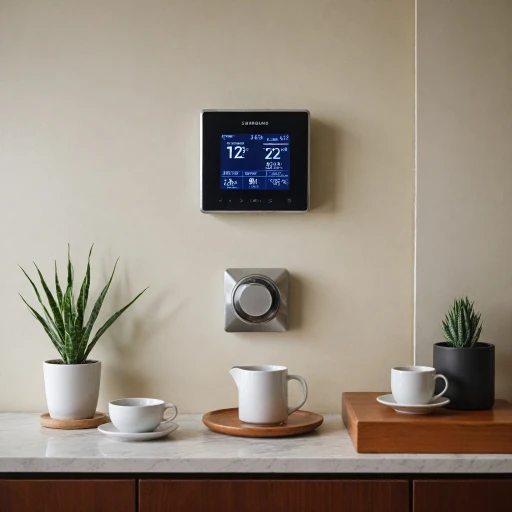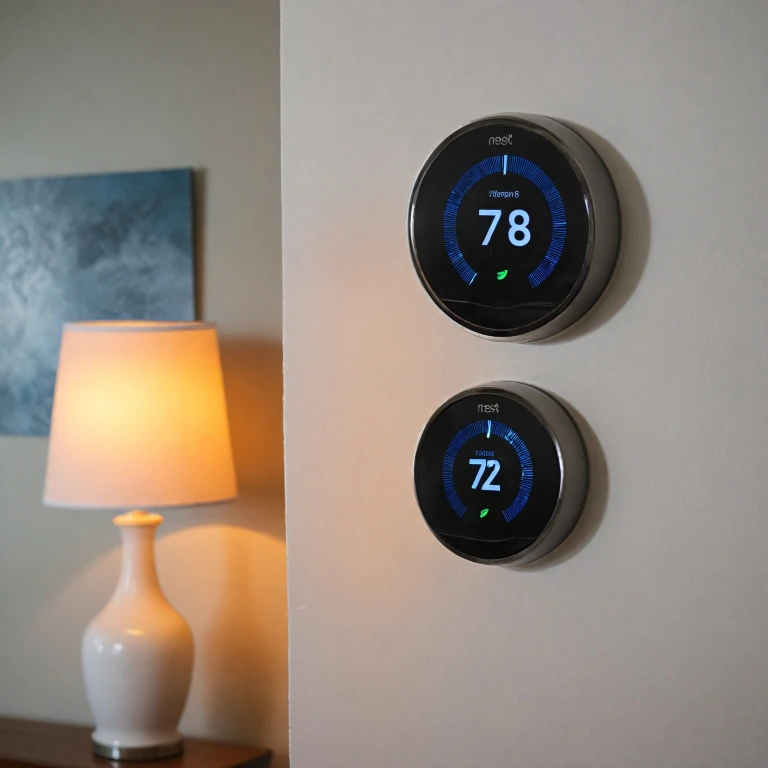Understanding the Basics of Thermostat Wiring
Grasping the Essentials of Thermostat Wiring
Understanding the wiring of a thermostat, particularly a smart thermostat such as the Nest Learning, can be quite complex but crucial. This not only helps with installation, but also ensures your heating and cooling systems function optimally. Traditional thermostats often rely on a basic set of wires to control HVAC systems, usually found in configurations with four or more wires.
In a typical setup, these wires can include:
- Red wire (R): Provides power to the system, known as the 24V AC power.
- Yellow wire (Y): Engages the air conditioning system or cooling function.
- White wire (W): Signals the heating system to activate, be it a furnace or another heat source.
- Green wire (G): Controls the fan operation, ensuring air circulates effectively.
These primary wires are commonly found in homes, enabling basic control over the HVAC system. However, when integrating a smart thermostat, the simplicity of these connections can pose challenges, especially considering modern thermostats like the Nest that may require additional power to run advanced features and maintain connectivity.
In the context of Nest thermostats, you'll often hear about the C-wire, or common wire, mentioned. The C-wire is significant as it provides continuous power, enabling the smart features of your thermostat to function without issues. For households with only four wires, compatibility questions often arise. Can the Nest Learning Thermostat work effectively in a four-wire setup? This is a common query in the community and will be further unpacked in the subsequent section dedicated to understanding these dynamics within your HVAC system. Understanding this wiring layout is pivotal, especially if you are to tackle installation or troubleshooting related issues effectively.
The Role of the C-Wire in Smart Thermostats
Why the C-Wire Matters in Smart Thermostats
When exploring the intricacies of thermostat wiring, it becomes apparent that the C-wire, or common wire, plays a pivotal role in ensuring the effective operation of smart thermostats like the Nest Learning Thermostat. This particular wire maintains a continuous flow of electrical power to your thermostat, which is crucial for its full range of features to function properly.
Traditional thermostats often didn’t require a constant source of power, as they simply toggled the heating or cooling systems on or off. However, smart thermostats, including Nest models, offer a suite of advanced functions, from learning user preferences to Wi-Fi connectivity, all of which are energy-intensive and require a steady power supply.
In systems that do not have a dedicated C-wire, smart thermostat companies have found alternative methods to draw the needed power, such as power-stealing or battery setups, but these are not always sufficient for optimal operation. Lack of a C-wire can sometimes lead to issues like frequent resets, faulty thermostat readings, or an inability to control HVAC systems efficiently. This makes understanding the wiring needs, especially the role of the C-wire, crucial for anyone considering switching to a Nest Learning Thermostat with a limited wire setup.
It's worth noting that not all homes will have an existing C-wire, particularly older homes with basic HVAC systems. For users with such setups, addressing the absence of a C-wire can pave the way for a smoother smart thermostat integration. Common solutions include using a C-wire adapter (often called a "power connector") or consulting a professional to introduce an additional wire. Engaging with knowledgeable HVAC professionals or community support groups may also provide insights into whether a certain system setup can support smart thermostats without a C-wire. As we delve deeper into Nest's compatibility with four-wire systems, understanding the C-wire's significant role becomes all the more critical.
Nest Learning Thermostat: Compatibility with Four Wires
Nest Learning Thermostat and Four-Wire Compatibility
The Nest Learning Thermostat, a leader in the smart thermostat market, is designed to enhance your heating and cooling systems' efficiency. However, when it comes to installation, wiring compatibility is crucial. Many households find themselves confronted with the question: Can a Nest Learning Thermostat function effectively with just four wires?
Yes, the Nest Learning Thermostat can indeed work with a four-wire setup, but there are considerations you need to keep in mind. Traditionally, a thermostat setup might comprise several wires corresponding to different functions: heating, cooling, fan, and the common wire (C-wire). While some systems have a dedicated C-wire, others operate without it, which can complicate the installation of some smart thermostats.
In a four-wire system, typically the wires connect as follows:
- Red wire (R): Provides power for the system
- White wire (W): Controls the heating function
- Yellow wire (Y): Responsible for cooling
- Green wire (G): Operates the fan
While this setup covers many standard functionalities, the absence of a C-wire can pose challenges. The C-wire, otherwise known as the 'common wire', provides a continuous power supply to the thermostat. This is essential for Wi-Fi-connected devices like the Nest Learning Thermostat, as they need constant power to function optimally. To gain a deeper understanding of
the role of the common wire in smart thermostats, it's beneficial to explore further literature.
In the absence of a C-wire, the Nest Learning Thermostat may still draw power through the existing wires, a process known as power stealing. However, this can sometimes lead to connectivity or charging issues, especially if the HVAC system isn’t running frequently enough to supply the required power. It's important for users to ensure their setup can handle "power-stealing" safely or consider alternatives like a power connector to bridge the gap.
For those in the thermostat community facing this wiring dilemma, installation tips, troubleshooting common issues, and exploring compatible alternatives can be invaluable steps toward achieving a well-functioning system with your new smart thermostat.
Installation Tips for a Four-Wire Setup
Tips for a Successful Installation
Setting up a Nest Learning Thermostat with just four wires can be straightforward if approached with the right preparation. Here are a few installation tips to ensure a smooth setup and help your smart thermostat work efficiently with your HVAC system:
- Identify Your Wires Before Beginning: Make sure to identify the wires connected to your existing thermostat. Typically, with four wires, you'll have a setup with R (power), Y (cooling), G (fan), and W (heating) wires. Double-check their functions as per your system's specifications.
- Use the Nest Compatibility Checker: It's a good idea to use the Nest compatibility checker tool available online prior to installation. This tool confirms whether your system supports a four-wire setup with the Nest Learning Thermostat.
- Consider Using the Nest Power Connector: When your wiring setup includes just four wires, you may need a solution to power the thermostat effectively. The Nest Power Connector can provide the necessary power, thereby replacing the need for a C-wire in certain systems.
- Installation Guides Are Your Friend: Follow the installation instructions provided by Google for the Nest thermostat closely. These guides are tailored to ensure your specific model operates properly with your wiring configuration.
- Double-Check All Connections: Once you have connected the wires to the Nest base, ensure they are snug and correct. Loose wiring may lead to operational issues, so secure each connection before attaching the Nest display.
If any issues arise, refer back to the wiring diagrams and the Nest support community for detailed guidance. Employing these tips will help you harness the full potential of your Nest Learning Thermostat, delivering optimal heating and cooling control for your home.
Troubleshooting Common Issues
Troubleshooting Typical Problems with Four-Wire Configurations
When using a Nest Learning Thermostat with just four wires, users can encounter a few common issues. Thankfully, these problems are usually manageable with some basic troubleshooting tips. Below are some potential challenges and solutions that could benefit the smart thermostat community.
- No Power to the Thermostat: One frequent issue is the thermostat failing to power up. As mentioned in the section discussing the C-wire's role, a lack of continuous power might result in the thermostat not functioning correctly. Verify that all wiring - particularly the power wire - is connected properly. Check the HVAC system’s breaker and ensure it hasn't tripped.
- Heating and Cooling Failures: If the thermostat isn't triggering the heating or cooling system, check if the wire assignments are correct. Misaligned wiring may disrupt the heat or cool cycles. Refer back to the basics of thermostat wiring to ensure all wires are in their correct terminals.
- Signal Loss with HVAC System: Registering connectivity issues with the HVAC system could be due to weak connections. Inspect each wire and ensure they're securely fastened in their terminals. Remember, any loose wire could impact the system’s efficiency.
- Unexpected Temperature Changes: Sometimes, the thermostat might show erratic temperature patterns. Check for a proper heat pump setup if you are experiencing heating cooling irregularities. Some systems, especially older setups, might not be fully compatible with smart thermostats, leading to unwanted temperature shifts.
Paying close attention to the installation and setup phases, as covered earlier, will mitigate some of these issues before they arise. However, if problems persist, engaging with the broader thermostat community through online forums and manufacturer support often provides valuable insights from those who have faced similar challenges.
By remaining patient and methodical, any hitches in your Nest thermostat setup can often be resolved, ensuring your smart thermostat's efficient operation in maintaining your home’s desired environment.
Exploring Alternatives and Accessories
Exploring Alternative Solutions and Accessories
In situations where a four-wire setup might not suffice, considering alternatives can be advantageous. Although Nest thermostats are designed to be versatile, some users might prefer exploring other compatible smart thermostats or supplemental accessories to enhance their HVAC system's performance.
- Consider Power Connectors: Modern smart thermostats heavily rely on consistent power. If there are power-related constraints in your existing wiring, power connectors can be a helpful addition. These connectors can deliver the needed C-wire functionality without additional wires or extensive modifications to your system.
- Evaluate Different Smart Thermostats: While Nest Learning Thermostat offers robust features, other models might provide better compatibility with existing wiring or unique functions tailored to specific needs. Examining models from other brands within the community can provide better insight into options that suit particular heating and cooling systems.
- Integrated Smart Home Systems: For those looking to expand beyond just controlling temperature, integrating the thermostat with a broader smart home system might offer additional control and convenience. Exploring how a learning thermostat works in conjunction with other devices can optimize home automation.
- Professional Advice and Installation: Some HVAC systems might benefit from professional evaluation to identify the most suitable setup. Pros can highlight potential wiring enhancements, recommend compatible thermostats, and ensure seamless installations.
Exploring these alternatives ensures that you harness the full potential of your HVAC and smart thermostat system while maintaining compatibility and efficiency.

